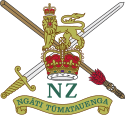| Royal New Zealand Nursing Corps | |
|---|---|
| Active | 1915–present |
| Country | |
| Branch | |
| Role | Medical support |
| Commanders | |
| Colonel-in-Chief | Anne, Princess Royal |
 |
| New Zealand Army New Zealand Defence Force |
|---|
| Components |
| Administration |
| Regiments |
| Corps |
| Equipment |
| New Zealand portal |

The Royal New Zealand Nursing Corps (RNZNC) is a corps of the New Zealand Army. The corps was initially formed in 1915 from civilian nurses who volunteered for service during World War I, and who were granted honorary officer ranks. A Nursing Reserve had been formed as part of the New Zealand Medical Corps on 14 May 1908. [1] Today, the corps is an officer-only corps that consists of commissioned officers who are employed for their specialist skills and knowledge as registered nurses, [2] the corps works in conjunction with the Royal New Zealand Army Medical Corps and the Royal New Zealand Dental Corps to promote "health and disease prevention" and to provide "care for the wounded and sick". [3] Nursing Officers in the New Zealand Army can be employed broadly in primary health, perioperative, surgical or emergency settings, [2] which can see RNZNC personnel providing health services in a garrison health centre, in a civilian practice, or deployed on operations. [4]
Contents
- New Zealand Nurses: Boer War
- New Zealand Nurses: Samoan Expeditionary Forces 1914
- Leadership
- Order of precedence
- References
- Further reading
Up until 1945, the corps was a part-time only formation with personnel being called up for full time service during times of war only. However, since then the RNZNC has developed into a corps of both Regular and Reserve personnel. Throughout the corps' history, personnel have been deployed to various operational theatres. Aside from service during World War I and World War II, the corps has deployed personnel support to operations during the Vietnam War, and more recently to peacekeeping operations such as those in Bosnia and Somalia in the 1990s, the 1991 Gulf War, the East Timor intervention, Bougainville, Iraq and Afghanistan. [4] [5]